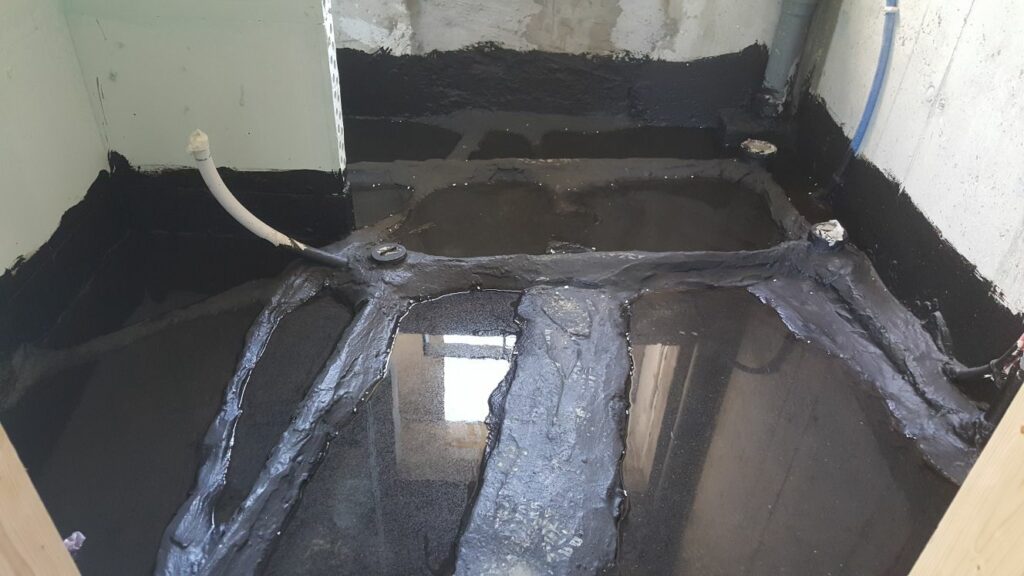Have you ever thought about what happens to all the water you spray around in a regular shower? Sure, there is drainage meant to ensure everything flows properly, but what about what’s around it? What about the water spraying on the walls? The drops dripping on the protrusions? The small puddles accumulating behind the sanitary fixtures?
Let’s talk about waterproofing the bathroom, the “wet room”. By its very nature, this is a room that must deal with the flow and pooling of water, alongside side effects like steam and humidity. To safely pass this you need a quality waterproofing layer professionally installed, otherwise all the moisture will seep through the tiles, flooring and joints between the sanitary fixtures and structure.
And then what? The water absorbed in the concrete or bricks comprising the home will return to you in the form of dampness on walls, mold and fungi (and no less important – angry neighbors from the floor below who will come to you with complaints. And rightly so). So for your bathroom to successfully handle the blessed flow without causing seepage and damage, it’s important to follow some basic rules.
Ready? Let’s start sealing.

It All Starts From Below
The most prone area for disaster is of course under the shower, undoubtedly the wettest section in the home. So if you decide to renew waterproofing below the shower, it is very important to ensure perfect application. Nothing less.
What does this mean? Dismantling the tiling layer, clearing the sand beneath it and stripping any remnant of the old waterproofing layer. Important: even if you purchase the best waterproofing materials on the market – such as for example Elastopaz, a polymer-enriched bituminous waterproofing material resistant even to standing water – if you don’t thoroughly cleanse the base of old waterproofing materials, the new waterproofing material will be unable to fully adhere (so what did we do really?)
And wait, even before laying the new waterproofing layer, be sure to complete any required plumbing work on site, and seal any crack in the concrete layer using a sealant material like Cementfaz Repair, for example.
What is a Fillet Anyway?
Another critical step without which the waterproofing task cannot be complete is filling fillets. Yes, you read right – fillets.
For those not fluent in jargon we’ll explain that the fillet is meant to eliminate angles at junctions between the wall and floor (and of course, interface points of sanitary fixtures with floor or walls). For this purpose a special waterproofing material is required that seals the joining point between tiles by filling the right angle with a rounded material that will create a surface on which water can slide off (because in the case of a right angle, water tends to accumulate and seep through the joint).
And speaking of walls – indoor waterproofing requires you to ensure waterproofing of the bathroom tiles. One small crack in the glaze is enough for water to seep through the tile covering layer into the walls and over time be absorbed in the concrete or bricks. And of course the gaps between tiles (called grout, in professional parlance) must be filled with sealant (and this is what renovators call caulk. By the way, in the bathroom it is important to apply a layer of caulk between floor tiles as well).
And what happens behind the tiles? To ensure long-lasting waterproofing, it is recommended to use a special plaster for waterproofing showers – scratch coat plaster, requiring no less than three full days to dry. The actual waterproofing material itself should be applied in full contact areas with water in the shower or bath in two coats, on alternating days. In these areas it is recommended to use a flexible waterproofing material, such as Cementfaz 102/308.
Don’t Compromise on Materials Quality
As you have surely realized already, performing waterproofing in the bathroom is a complex, thorough task not done every day. And so, in this situation, the choice of quality raw materials that will ensure optimal long-term waterproofing has special importance.
And here’s an important tip in this context: some contractors, to save on costs, will purchase expired products at discounted prices. It is important to verify that your waterproofing materials have not ended their shelf life before they got to you, otherwise your wet room will become the building’s wet woe.
The bottom line is that there are many product types that can provide you with decent waterproofing solutions, with varying functions and different price ranges. What matters is that you do not compromise on non-standard products, of course, and don’t let your contractor off easy: when it comes to bathroom waterproofing go with a veteran Israeli product with proven reputation and success record. In short – when making waterproofing decisions, go with the best: Pazkar, because waterproofing is what we’ve been doing since 1934.











